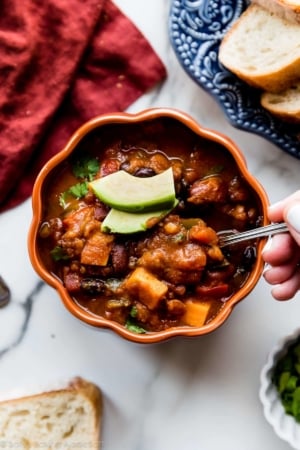This recipe is brought to you in partnership with Red Star Yeast. My popular soft dinner rolls are flaky, soft, and buttery. And so are today’s sweet potato version. But today’s recipe produces slightly sweeter and richer-tasting rolls. My team and I tested 4 versions until we found the perfect balance of flavor and fluff! My entire family (kids included) have been enjoying these for weeks. We LOVE them.
Here’s Why You’ll Love These Sweet Potato Rolls
This recipe makes a big batch—20 large rolls—perfect for sharing. Super soft texture and subtly sweet, buttery flavor. Shorter rise time than regular dinner rolls. Make-ahead friendly: Delicious warm and fresh from the oven, but somehow the flavor of these sweet potato rolls is even BETTER after they’ve cooled. This makes this sweet potato dinner roll recipe a great choice for making ahead of time, if your oven is going to be in continual use leading up to a big meal like Thanksgiving. Freeze well: Make them even further in advance and freeze them for later.
What Are Potato Rolls?
Have you ever had a potato roll? Gorgeously golden on top, and pillowy-soft throughout, potato rolls—traditionally made by the Pennsylvania Dutch—are made with potato flour replacing a portion of wheat flour, giving the bread a sweeter taste and softer texture than regular white rolls. The texture comes from the potato starch and its ability to absorb and retain more moisture than wheat can. I learned from the brilliant bakers over at King Arthur Baking that the higher the starch level in your bread dough, the more tender your resulting bread will be. The potato (including sweet potatoes) is one of the starchiest vegetables out there. So when you add potato to your bread dough you’re upping the dough’s starch content, effectively increasing the resulting bread’s total liquid retention—which translates to bread with soft, moist texture and a long shelf life. An added benefit is potatoes also boost the overall nutritional value, making it comparable to whole-wheat bread for fiber and nutrients such as zinc and iron, with significantly more potassium than either white or whole-wheat bread. Now, we are taking this concept for potato rolls and using sweet potato instead. This means even more sweetness, plus an added boost of vitamin A! (Not trying to pretend these rolls are healthy… but we’ll take our vitamins where we can get them, right?)
Ingredients You Need for This Rich Dough:
While the starch from the sweet potato already makes for a soft texture, we’re also using butter, eggs, and whole milk to make a rich dough that turns out perfectly pillowy yeast rolls. Here’s a quick overview of the difference in these two types of bread doughs:
Rich dough: The softer the bread, the more fat in the dough. For example, this dough includes whole milk, butter, and eggs. Recipes like my easy cinnamon rolls, pizza pull-apart rolls, and brown butter sage dinner rolls all start with a rich dough. Lean dough: The crustier and chewier the bread, the less fat in the dough. Recipes like chewy homemade bagels and soft pretzels, pizza dough, and artisan bread all use a lean dough.
Key Steps in This Recipe
Peel, chop, and boil a sweet potato until tender. This takes about 10–12 minutes. Once your sweet potato is soft, drain and mash it. You can do this with a potato masher, pastry cutter, fork, or even an electric mixer or food processor. The next step is to proof your yeast, a step I take even if I’m using instant yeast. All you do is mix the yeast with the warm liquid (milk), and a little sugar (honey). Cover and let it sit for 5–10 minutes until foamy and frothy on top. This proves your yeast is active and ready to get to work. Then, add the rest of the ingredients to form a soft dough. (The mashed sweet potato will have cooled a bit by now.) Add enough flour for the dough to come together into a kneadable mass; it should be pulling away from the sides of the stand mixer’s bowl. The dough should feel slightly tacky, but not overly sticky. On a lightly floured work surface, using the heels of your hands, stretch and fold the dough with gentle motion. If you’d like a visual of how to knead the dough by hand, you can watch the full video tutorial in my post on how to knead dough. Pictured on the left below is the dough after kneading. It’s smooth and stretchy, and ready to rise. Place the dough in a large greased bowl, turn the dough to coat it in the oil, and then cover it and set it aside. It will double in size in about 1–2 hours, pictured on the right.
Shaping the Rolls
Take a piece and stretch the top of the dough while pinching and sealing the bottom. Make sure the rolls are smooth on top and sealed on the bottom. Arrange them in a greased baking pan. A 9×13-inch baking pan is ideal for these sweet potato rolls, but you can bake them on a lined baking sheet or in two 9-inch round or square pans instead. Loosely cover, and let the shaped rolls rise for another 30 to 45 minutes before baking. Just wait until you smell these baking! The rolls are done when they’re golden brown on top. Brush the warm rolls with a little melted butter, and finish with an optional sprinkle of sea salt. If you’d like a recommendation, I use and love Maldon flaky sea salt. (Not sponsored, just what I personally use!) If you want to take them to the next level, these are AHHHH-mazing with homemade cinnamon butter. (Honey butter too, of course!) Serve them alongside any of these fall dinner recipes, and here are some more ideas:















